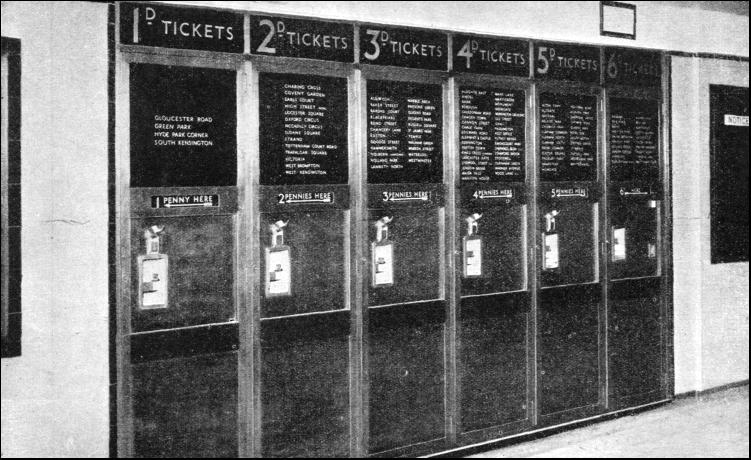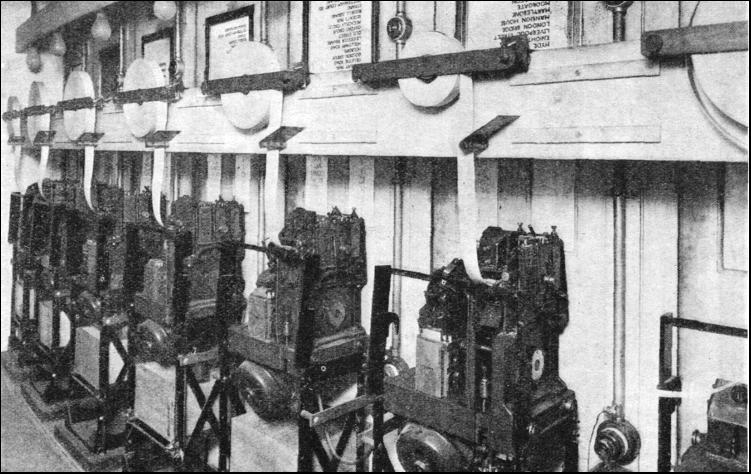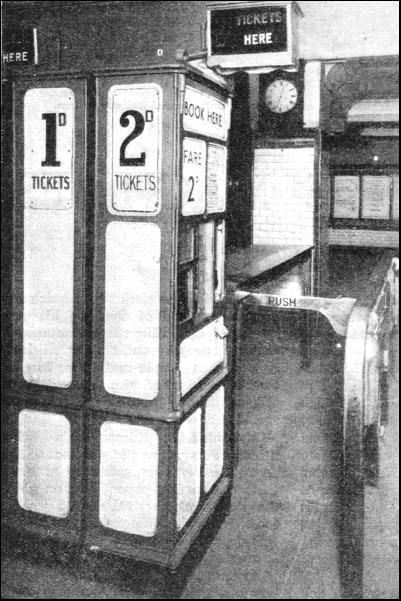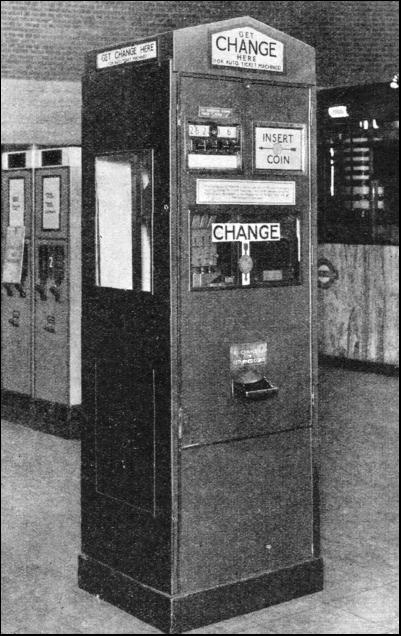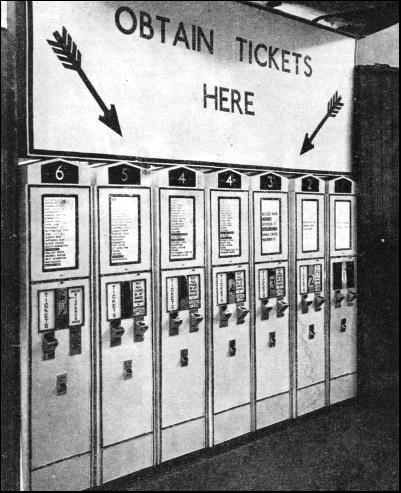|
|
The first railway tickets were generally made of paper. They were partly printed and partly handwritten by the booking clerk, who retained the left-hand portion as a counterfoil, on which he entered the amount paid. The part retained by the passenger had printed on it the names of the stations of arrival and departure, but the date, amount, and train by which it was available had to be entered by the clerk. The inconveniences of the primitive paper ticket and of the clerical work involved by its use soon became evident, and the first material improvement was due to Thomas Edmondson, then a chief booking clerk on the Manchester and Leeds, whose machine was first employed on the Liverpool and Manchester, and shortly afterwards, in an improved form, introduced on the Manchester and Leeds, and London and Blackwall, where it was adopted in or about 1840. To all intents and purposes, Edmondson invented the system of to-day in its main outlines. The tickets, which were printed on cardboard and serially numbered, were inserted in vertical compartments, one for each station, the compartments themselves being divided by horizontal partitions so as to keep distinct the tickets for different classes of passenger. A spiral spring kept the contents in position, and enabled the easy withdrawal of one ticket without disturbing the remainder. Serial numbering represented a much more important innovation than may appear on the surface. It not only lessened clerical labour (and thus reduced delay at the booking office), but it also provided the clerk with a quick and accurate method of checking his cash receipts. By noting the top number in each rack on going and coming off duty, it is now a simple matter for him to ascertain whether the money taken tallies with the number and nature of the tickets sold.
Substantially, Edmondson's ticket machine survives as the standard to this day. It is, however, necessary at times to issue a card or paper ticket on which the name of the arrival station is written, if bookings to the particular destination from the point of departure are unusual. On issue, tickets are stamped with the date, and since this means two printings, at different times and places, many machines have been designed for printing tickets at the moment of issue, thus effecting a considerable saving in time. These range from appliances that will deliver a ticket for only a single prescribed station to installations that virtually do the work of a booking office. On the Continent this latter type has been developed to the extent of printing and issuing tickets in all three classes for a considerable number of stations. In addition it issues such special varieties as tickets for soldiers at reduced rates, and for dogs accompanied by passengers. The machines which combine printing and issuing are of two main types—those in which the printing and issuing mechanism is set in motion by the booking clerk, and in which it is operated on the familiar penny-in-the-slot principle by the insertion of one or more coins by the passenger. Special forms of the latter type also give change. In some machines, the printing is done on cardboard blanks of regulation size and shape, while others are loaded with long strips wound on spools, of which a portion is, on printing, cut to the required size. On no system in the world has machinery been used to such a remarkable extent as on the London Underground railways, and a description of their methods will serve to describe the mechanical system in general.
On the Underground the situation had become particularly complicated prior to the use of mechanical methods, because of the immense variety it was necessary to keep in stock. Prior to the beginning of 1911 it was the practice to have, save in certain instances, a separate form of ticket from each station to every other station. That was, and is, the system in use on the main lines, but on short-distance urban railways, traffic is much denser, and the much shorter intervals between trains necessitates speeding up the issue of tickets to a degree not required at either a great terminus or a country station. (Tests have shown that over 1,300 people may buy tickets in an hour at a busy Tube station ; this is equal to more than the issue of one ticket every three seconds. Rather more than two out of every three passengers also require change.) Hence, it was considered essential to devise means for facilitating quicker booking, and those means had also to provide for the simplifying of the issue of tickets where the passenger had an alternative route at his disposal. The first step was the adoption of the so-called "scheme ticket," the principle of which is that it is available to a whole group of stations to which the particular fare applies. For example, a threepenny ticket may frank the passenger to as many as a dozen separate terminal points, and give him the choice of several alternative routes, in addition to being available at every intermediate station on those routes. The system was first adopted on the Bakerloo Tube in 1911, and by 1927 had been extended to cover the whole of the Underground lines, including the Metropolitan, Metropolitan District, and East London Railways. Its immediate effect was to bring about a reduction in the number of sets of tickets in stock, which between 1925 and 1928 were brought down from about 50,000 to 20,000.
The "scheme ticket" was, however, only one step. Mechanization in an elementary form had begun as early as 1904, when the pull-bar automatic machine was first installed on the Central London. This appliance is of the standard coin-slot type, and issues ready-printed tickets. Four years later an electrically operated coin-slot machine, also issuing standard card tickets, was put in service on the District and London Electric Railways. In this type the passenger does not operate the machine, which is worked electrically after he has inserted his money. Before leaving these earlier devices, reference should be made to the passimeter booking office. The passimeter is a form of turnstile, and when it is attached to the electric slot machine the installation carries out the fourfold duties of issuing, dating, and cancelling the ticket, and of electrically releasing the turnstile itself. Although its use thus materially lightens the work of the booking office, it does not eliminate the human element in ticket issuing, since, as mentioned above, so large a proportion of passengers require change. The turnstile, it may be added, automatically re-sets itself after the passenger has passed through. The first passimeter was installed in 1921 at Kilburn Park Station (Bakerloo), where it proved such a success that it henceforth became part of the standard equipment of new or reconstructed stations. At the same time that the passimeter was first under consideration, experiments were being made with automatic machines for use inside the booking offices. These were of two types, the "Automaticket" and the "Rolltic."
The first, which is driven by an electric motor of about one-sixth horse-power, is fitted into the counter in front of the booking office window, and will, by depression of a key, issue up to six tickets at a time. The tickets themselves are housed in containers beneath the machine, which has a device for cutting the card strip according to the number of tickets required. In the "Rolltic" the tickets are in the form of a long strip and are suspended on spindles, and the machine is of two types, issuing six and eight varieties of tickets respectively. The "Rolltic" rolls represent 1,000 tickets, while those on the "Automaticket" are inserted in bundles of 2,000. All the devices hitherto described are merely appliances for issuing ready-printed tickets. The "Rapid" machine, which is similar in general lines to the "Rolltic," also prints the tickets from. plain rolls of cardboard, and its use has been described by the Operating Manager of the Underground system as saving so much money, time and labour as to have "revolutionized booking office and ticket printing methods." Operation, which is electrical, is by pressure on one or more buttons, according to the type of ticket required ; the machine prints, cuts and delivers the ticket, and can issue four a second. All types of tickets—ordinary single and return, cheap day return, and workmen's—covering any journey from the station of issue, are printed, and only fifteen seconds are needed for the daily changing of the date, while the insertion of a fresh roll of paper requires no more than half a minute. Change-giving machines are in use both in the booking offices and for operation by the passengers themselves, and in the latter instance can also be combined with automatic printing appliances.
Printing is here effected on a roll long enough to provide two thousand tickets, thus avoiding the necessity of constantly refilling at busy stations, which is one of the drawbacks on the coin-operated machines not equipped with a printing device. Tickets are issued at fares of from one penny to fivepence, and change is given for sixpence and one shilling. The machine is, of course, designed to issue tickets without giving change when the passenger has provided himself with the correct fare. Recent tests have shown that the passenger can aid the machine in the matter of speeding up booking. This is particularly noticeable when it comes to picking up change, and the booking offices at busy stations are now equipped with a special change plate designed with an upward curved rim, which enables passengers to scoop up their money instead of sliding it towards them. At certain stations, such as Baker Street, the ticket clerk not only has charge of a mechanized booking office, but also controls the opening and closing of the lift gates. There are also some stations normally handling a limited traffic, such as the Aldwych terminus of the Piccadilly Tube (on which section two-car trains are run during the rush hours, while single-vehicle units are adequate during the rest of the day), where the process is reversed, and the liftman is also the booking clerk. At these stations the booking office is installed in the lift itself, and the tickets are both of standard card pattern and printed on continuous rolls of thinner material. Mention has been made of the fact that the most expensive printing and issuing machines soon save their cost. One reason for the mechanization of the booking office is that on railway systems where the average passenger is carried for only a short distance, the expenditure of the ticket department is relatively high in comparison with operating costs as a whole. On the London Underground it represents about £200,000 a year, or approximately 6 per cent of the total operating expenditure. Machinery effects an economy, and at the same time provides the public with certain added facilities, as at Trafalgar Square, where the equipment comprises a booking office, a battery of ticket-issuing machines operated by passengers themselves, and a passimeter booth. With an installation of this type, congestion at the booking office windows is materially lessened, especially at times when there is a sudden and unexpected influx of passengers, as during a thunderstorm.
Many thanks for your help
|
   Share this page on Facebook - Share  [email protected] |

